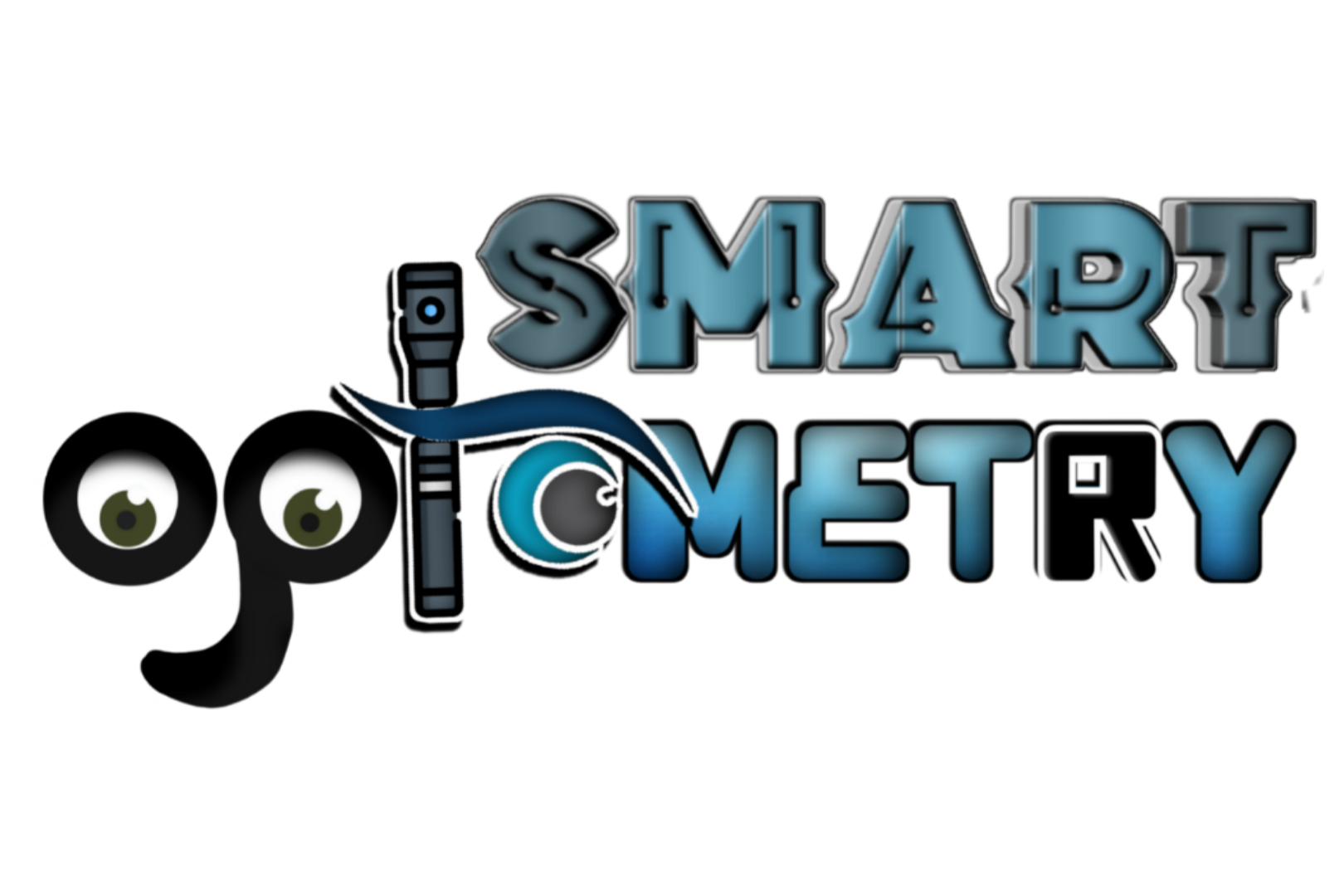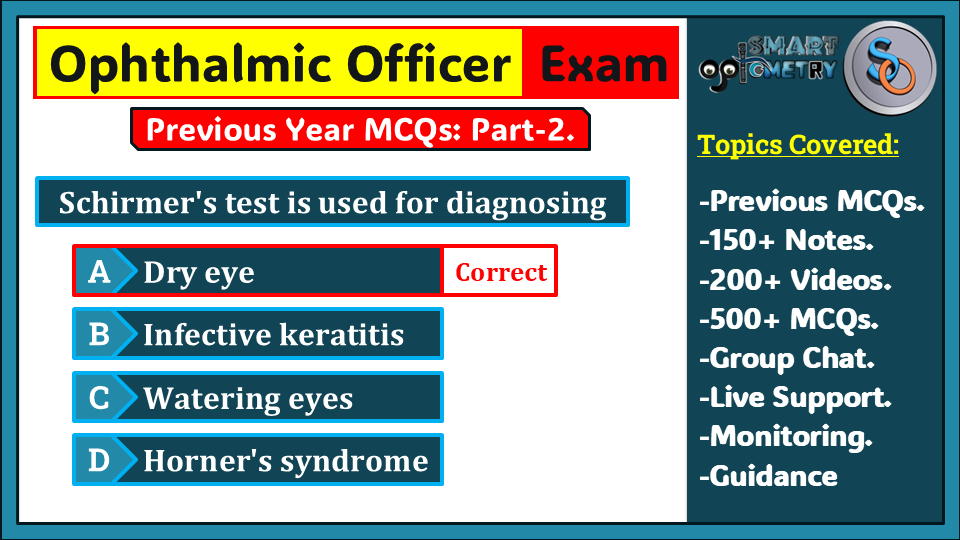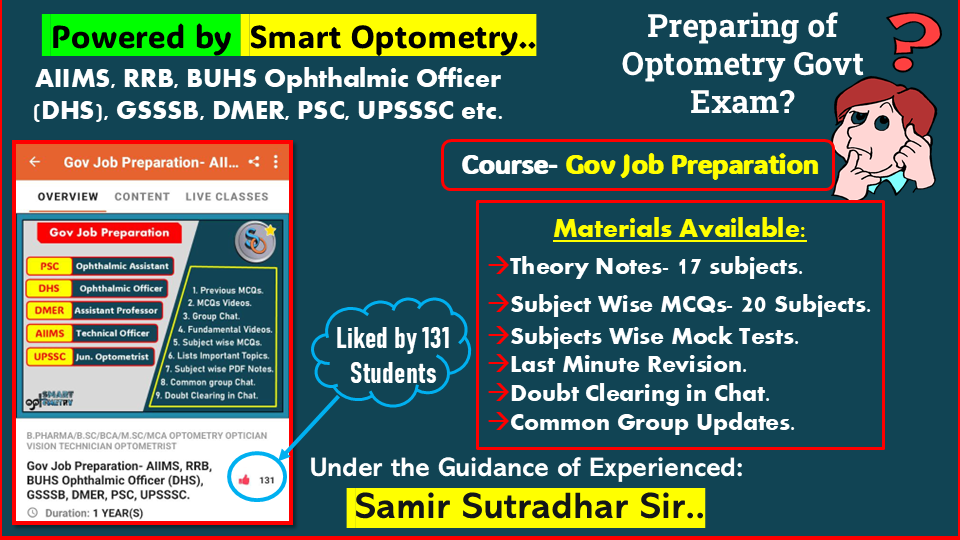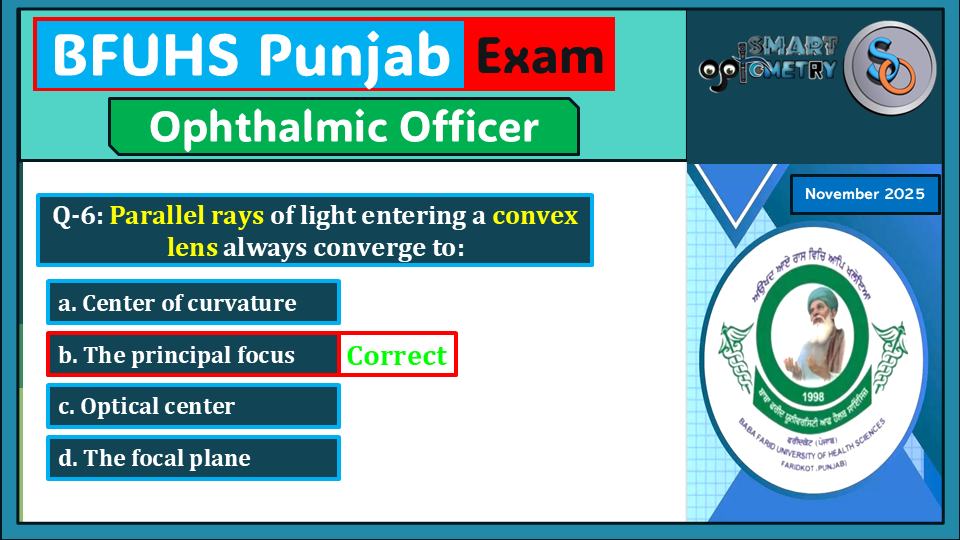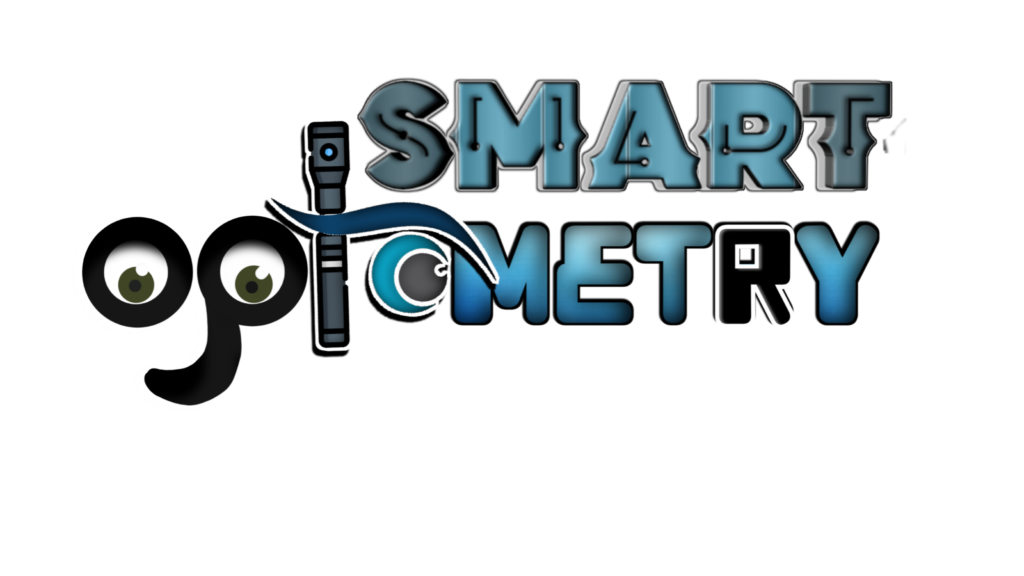21. Mirage is an example of:
- A) Reflection of light
- B) Refraction of light
- C) Total internal reflection of light
- D) Scattering of light
Click “Show more” to see the answer and explanation.
Answer: C) Total internal reflection of light
Explanation:
Mirages occur due to the total internal reflection of light rays in layers of air at varying temperatures.
Note: Prepare for your Ophthalmic Officer Exam by DHS under experience Samir Sutradhar sir. Enroll in our Course “MCQs in Optometry” that will give you: Basic Notes, Fundamental Videos, Subjectwise MCQs, PDF MCQs, Previous Years MCQs, RAPID Access Guide for Optometrists PDF Book, Group Chat, Live Support.
.
.
22. What will be the power of a concave lens of focal length 5 meters?
- A) 5D
- B) -5D
- C) 0.2D
- D) -0.2D
.
.
23. A focimeter cannot measure the:
- A) Amplitude of accommodation
- B) Dioptric vertex power
- C) Prism of a lens
- D) Cylindrical axis
.
.
24. CR-39 (Columbia resin 39) is used for/as:
- A) Anti-glaucoma medication
- B) Spectacle lens manufacture
- C) Ink in OCT machine printers
- D) Antibiotic eyedrops
Click “Show more” to see the answer and explanation.
Answer: B) Spectacle lens manufacture
Explanation:
CR-39 is a lightweight, durable plastic material commonly used for making spectacle lenses.
Note: Prepare for Ophthalmic Officer Exam by DHS with our course “MCQs in Optometry”. This course provides: Basic Notes, Fundamental Videos, Subjectwise MCQs, PDF MCQs, Previous Years MCQs, RAPID Access Guide for Optometrists PDF Book, Group Chat, Live Support.
.
.
25. In objective refraction:
- A) Accommodation is stimulated if the patient stares at the light from the retinoscope
- B) ‘With’ motion occurs in high myope if the sleeve of the retinoscope is placed in the plano mirror position
- C) Movement of the reflex decreases as the neutralization point is near
- D) The power of the working distance lens in diopters is proportional to the working distance in meters
Click “Show more” to see the answer and explanation.
Answer: A) Accommodation is stimulated if the patient stares at the light from the retinoscope
Explanation:
In objective refraction, the examiner measures refractive errors without requiring responses from the patient. If the patient fixates directly on the retinoscope light, it can stimulate accommodation, especially in young patients with active focusing mechanisms. This can lead to inaccurate results, and accommodation must be relaxed by having the patient focus on a distant object or using cycloplegic drops.
.
.
26. Which of the following tests does not depend on binocular vision?
- A) Maddox rod
- B) Worth’s four dots test
- C) Duochrome tests
- D) Bagolini’s test
.
.
27. The following is the power cross of a patient examined at 2/3 meters (before correcting for the working distance). The correct statement is:
- A) When a streak retinoscopy is used to neutralise the eye at 30°, the power of the lens needed is +4.00
- B) If the patient were to accommodate, the power cross will have a higher plus power
- C) If a +5.00DS lens is placed in the trial frame, a -1.00DC is required to neutralise the eye at 120°
- D) The lens required for correcting this patient’s refraction if the working distance is 1/2 m can be +3.00/-1.00 X 30°
.
.
28. A 42-year-old myopic man recently changes his glasses and finds them uncomfortable despite having a visual acuity of 6/6 in both eyes. The following may be responsible:
- A) Scratchy lens
- B) Onset of presbyopia
- C) Change of axis
- D) Decentering of the lens
Click “Show more” to see the answer and explanation.
Answer: B) Onset of presbyopia
Explanation:
Myopes often experience discomfort due to the onset of presbyopia, especially in their early 40s.
Note: Enroll in our Course “MCQs in Optometry” to prepare for Ophthalmic Officer Exam by DHS under Experienced Samir Sutradhar sir. This course will give you: Basic Notes, Fundamental Videos, Subjectwise MCQs, PDF MCQs, Previous Years MCQs, RAPID Access Guide for Optometrists PDF Book, Group Chat, Live Support.
.
.
29. The longest extraocular muscle is:
- A) Superior oblique
- B) Inferior oblique
- C) Superior rectus
- D) Inferior rectus
Click “Show more” to see the answer and explanation.
Answer: A) Superior oblique
Explanation:
The superior oblique muscle is the longest extraocular muscle. It originates from the sphenoid bone, passes through the trochlea (a pulley-like structure), and then inserts onto the eye. Its length and unique structure allow it to perform torsional movements (intorsion) along with depression and abduction of the eye.
.
.
30. Diameter of the optic disc is:
- A) 1.5 mm
- B) 3.5 mm
- C) 2.5 mm
- D) 5 mm
.
.
31. Schwalbe’s line forming part of the angle of the anterior chamber is the prominent end of:
- A) Sclera
- B) Descemet’s membrane of cornea
- C) Anterior limit of trabecular meshwork
- D) Posterior limit of trabecular meshwork
.
.
32. Capsule of the crystalline lens is thinnest at:
- A) Anterior pole
- B) Posterior pole
- C) Equator
- D) None of the above
Click “Show more” to see the answer and explanation.
Answer: B) Posterior pole
Explanation:
The posterior capsule of the lens is the thinnest, measuring around 4 µm.
Note: Our Course “MCQs in Optometry” with 95% success rate will help to prepare for Ophthalmic Officer Exam by DHS. Prepare under experienced Samir Sutradhar sir.
.
.
33. The youngest lens fibres are present in:
- A) Central core of the lens nucleus
- B) Outer layer of the nucleus
- C) Deeper layer of the cortex
- D) Superficial layer of the cortex
.
.
34. Smallest diameter of the eyeball is:
- A) Vertical
- B) Horizontal
- C) More than 24 mm
- D) Anteroposterior
Click “Show more” to see the answer and explanation.
Answer: A) Vertical
Explanation:
The human eyeball has three major diameters:
Horizontal diameter: ~24 mm (widest).
Anteroposterior diameter: ~23.5 mm.
Vertical diameter: ~23 mm (smallest).
The vertical dimension is slightly shorter than the horizontal, giving the eyeball a slight asymmetry in shape.
.
.
35. Anterior segment of the eyeball includes structures lying in front of the:
- A) Iris
- B) Crystalline lens
- C) Vitreous body
- D) Corne
Click “Show more” to see the answer and explanation.
Answer: C) Vitreous body
Explanation:
The anterior segment of the eyeball refers to the part of the eye in front of the vitreous body, including:
Cornea
Anterior and posterior chambers (filled with aqueous humor)
Iris
Ciliary body
Crystalline lens.
The vitreous body lies in the posterior segment of the eye, separating it from the anterior segment.
.
.
36. A one-month-old baby is brought with complaints of photophobia and watering. Clinical examination shows normal tear passages and clear but large cornea. The most likely diagnosis is:
- A) Congenital dacryocystitis
- B) Retinopathy of prematurity
- C) Keratoconus
- D) Congenital glaucoma
Click “Show more” to see the answer and explanation.
Answer: D) Congenital glaucoma
Explanation:
Congenital glaucoma presents with large cornea (buphthalmos), photophobia, and epiphora.
Note: Prepare for your Ophthalmic Officer Exam by DHS under experience Samir Sutradhar sir. Enroll in our Course “MCQs in Optometry” that will give you: Basic Notes, Fundamental Videos, Subjectwise MCQs, PDF MCQs, Previous Years MCQs, RAPID Access Guide for Optometrists PDF Book, Group Chat, Live Support.
.
.
37. Schirmer’s test is used for diagnosing:
- A) Dry eye
- B) Infective keratitis
- C) Watering eyes
- D) Horner’s syndrome
.
.
38. You have been referred a case of open-angle glaucoma. Which of the following would be an important point in diagnosing the case?
- A) Shallow anterior chamber
- B) Optic disc cupping
- C) Narrow angle
- D) Visual acuity and refractive error
.
.
39. Optic nerve function is best studied by:
- A) Direct Ophthalmoscope
- B) Retinoscope
- C) Perimetry
- D) Gonioscopy
.
.
40. The best treatment for amblyopia is:
- A) Orthoptic exercises
- B) Occlusion
- C) Surgery
- D) Best treat after age 10 years
Click “Show more” to see the answer and explanation.
Answer: B) Occlusion
Explanation:
Occlusion therapy (patching the better eye) is the gold standard treatment for amblyopia, especially in early childhood.
Note: Prepare for Ophthalmic Officer Exam by DHS with our course “MCQs in Optometry”. This course provides: Basic Notes, Fundamental Videos, Subjectwise MCQs, PDF MCQs, Previous Years MCQs, RAPID Access Guide for Optometrists PDF Book, Group Chat, Live Support.
.
.
Blog Description:
Are you preparing for the Ophthalmic Officer Exam and looking for comprehensive guidance to ace it? In this blog, we present 20 previous year MCQs carefully selected from the Ophthalmic Officer Exam Previous Year Question Papers, designed to help you understand the Ophthalmic Officer Exam Pattern and boost your preparation. Whether you’re exploring the Ophthalmic Officer Exam Syllabus or searching for the best Ophthalmic Officer Exam Study Material, this blog has got you covered.
We also provide insights into the Ophthalmic Officer Exam Eligibility Criteria, guiding you on how to apply through the Ophthalmic Officer Exam Application Form and stay updated on the Ophthalmic Officer Exam Recruitment Notification. Don’t miss important updates like the release of the Ophthalmic Officer Exam Admit Card, Ophthalmic Officer Exam Dates, and Ophthalmic Officer Exam Result to ensure you’re always one step ahead.
This blog is a must-read for aspirants aiming to succeed in the Ophthalmic Officer Exam with ease. Dive in to test your knowledge and enhance your preparation today!
Tags:
Ophthalmic Officer Exam Syllabus, Ophthalmic Officer Exam Eligibility Criteria, Ophthalmic Officer Exam Previous Year Question Papers, Ophthalmic Officer Exam Pattern, Ophthalmic Officer Exam Study Material, Ophthalmic Officer Exam Recruitment Notification, Ophthalmic Officer Exam Application Form, Ophthalmic Officer Exam Admit Card, Ophthalmic Exam Officer Exam Dates, Ophthalmic Officer Exam Result,
- Check Our Courses: Ophthalmic Instrumentation, Clinical Refraction, Contact Lens, Binocular Vision, Dispensing Optics, MCQs in Optometry
- Download our App “Optometry Notes & MCQs” from Google Play Store.
